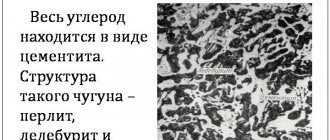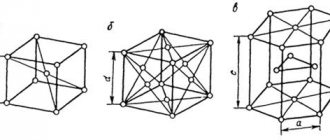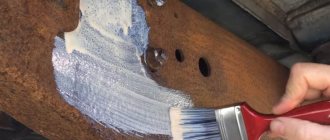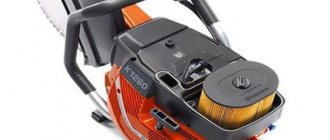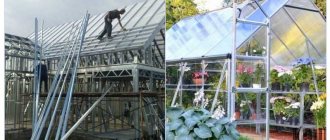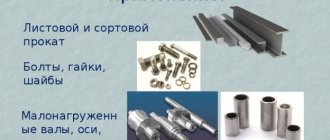Microstructure of cast iron
Graphite.
Graphite in cast iron is a crystalline variety of carbon, having a hexagonal lattice with a layered arrangement of atoms or a solid solution of iron and other elements based on it. Under a microscope, graphite has a black (dark) appearance.
For gray cast iron, the best are small, swirling inclusions of lamellar graphite (Fig. 1, a). Large and straight graphite inclusions (Fig. 1, b), separating the metal base and sharply reducing the tensile strength of gray cast iron, are unacceptable.
Fig. 1. Inclusions of floating graphite before etching; x200
In high-strength magnesium cast iron, graphite inclusions are spherical (Figure 2, a), and in malleable cast iron they are flake-shaped (Figure 2, b).
Figure 2. Graphite inclusions in the microstructure of cast iron before etching:
a-spherical in high-strength, x200;
b-flaky in malleable, x500.
Preparation of microsections with graphite in the structure requires special care so as not to tear out or wash out the powdered graphite. It is more convenient to observe graphite on a light metal base before etching.
Metal base of gray cast iron.
After etching, the microstructure of gray cast iron may turn out to be pearlitic (Fig. 32, a), corresponding to high hardness, wear resistance and at the same time satisfactory machinability.
The presence of ferrite in the metal base (Fig. 32, b) reduces the mechanical properties of gray cast iron and especially its hardness and wear resistance. The ferritic microstructure of gray cast iron (Fig. 33, a) leads to unacceptably low hardness and wear resistance.
Rice. 3. Gray cast iron after pickling:
a-pearlite-graphite microstructure, corresponding to high hardness and wear resistance, x1000;
b-pearlite-ferrite-graphite microstructure, corresponding to reduced hardness and wear resistance, x 200.
The ferritic microstructure of gray cast iron (Fig. 4, a) leads to unacceptably low hardness and wear resistance. The pearlite-cementite metal base of cast iron (Fig. 4, b) makes cast iron hard and impairs its machinability with cutting tools, and large cementite deposits cause chilling and prevent its processing by cutting.
Figure 4. Gray cast iron
a-ferrite-graphite microstructure, corresponding to very low hardness and wear resistance, x500; b - cementite-pearlite-graphite microstructure, corresponding to very poor machinability with a cutting tool, x200.
Precipitates of phosphide eutectic in cast iron, which are very hard, act in a similar way: triple phosphide eutectic Fe3P—Fe3C—Fe (Figure 5., α) and double Fe3P—Fe (Figure 5, b).
Rice. 5. Phosphide eutectic in gray cast iron, characterized by wear resistance, hardness and brittleness, x1000
Microstructure of low-carbon modified cast iron.
Before modification, this cast iron has a microstructure (Figure 6, a) consisting of pearlite and cementite. After modifying cast iron with a mixture of 75% ferrosilicon and aluminum, its microstructure
(Fig. 6b) consists of small swirling, uniformly distributed graphite inclusions in a pearlite metal base.
Rice. 6. Low carbon cast iron, x200
a - microstructure before modification - cementite and pearlite; b- the same, but after modification with ferrosilicon - graphite and pearlite
Microstructure of high-strength magnesium cast iron.
Cast iron before modification has the microstructure of gray cast iron with flake graphite (Fig. 36, a). After adding a master alloy of magnesium with 75% ferrosilicon, its macrostructure consists of pearlite and ferrite surrounding spherical graphite (Fig. 36.6).
Fig 7. High-strength cast iron with nodular graphite, x200
a - microstructure before modification; b- the same, after modification with a magnesium alloy with ferrosilicon - nodular graphite, ferrite and pearlite
Microstructure of ductile cast iron.
The microstructure of white cast iron, from which malleable cast iron is obtained by annealing, consists of perlite and separate deposits of ledeburite and structurally free cementite (Fig. 8, a). Annealing at 950° to carry out the first stage of graphitization (graphitization of structurally free cementite and ledeburite) gives a structure (Fig. 8b) consisting of flake graphite surrounded by ferrite and pearlite. The second stage of graphitization (graphitization of cementite, which is part of pearlite) occurs at 735° and gives a structure (Fig. 8, c) consisting of flake graphite and ferrite grains. This structure is characterized by good ductility and high elongation; and viscosity.
Rice. 8. Malleable cast iron, x250.
a- before annealing (white hypoeutectic cast iron),
b- after annealing (after the first stage of graphitization),
c- after annealing (after the second stage of graphitization).
Main characteristics
Gray cast iron is the basis of ferrous metallurgy, as it is obtained from the reduction of iron ores using carbon fuel (coke). As a result, in addition to the chemical reaction of reduction of iron oxides, the alloy is additionally saturated with free carbon.
The high free carbon content determines the mechanical properties of gray cast iron. One of the main qualities that allow gray cast iron to be used not only as a pigment metal is its high casting qualities and low shrinkage during solidification. Molten metal has high fluidity, so it can be used to make castings of complex shapes.
Gray cast iron plates
The restriction on the use of products made of gray cast iron is due to the fact that it has low bending strength and high fragility. At the same time, the compressive strength of gray cast iron is very high.
Despite its high fragility, such a characteristic as the wear resistance of cast iron allows it to be used in products operating under friction conditions. Under these conditions, the antifriction properties of the alloy have a strong influence.
The presence of a large amount of carbon reduces the density of gray cast iron compared to most types of steel and ranges from 6.8 to 7.3 tons per m3.
Due to the presence of carbon inclusions, welding gray cast iron is practically impossible. There are welding technologies under certain conditions. This is preheating of parts, the use of special high-carbon electrodes, but still, the structure of the weld metal is very different from the base material. The parts to be welded must be cooled slowly to eliminate stress in the weld area.
Advantages and disadvantages[edit]
Gray cast iron is a common engineering alloy due to its relatively low cost and good machinability, a result of the graphite lubricating the cut and breaking up the chips.
It also has good abrasion and wear resistance because the graphite flakes are self-lubricating. Graphite also gives gray cast iron excellent damping properties as it absorbs energy and converts it into heat. [3] Gray cast iron cannot be processed (forging, pressing, rolling, etc.) even at temperature. Relative damping capacity of different metals
| Materials | Damping Capacity† |
| Gray cast iron (high carbon equivalent) | 100–500 |
| Gray cast iron (low carbon equivalent) | 20–100 |
| Malleable iron | 5–20 |
| Malleable iron | 8–15 |
| White iron | 2–4 |
| Become | 4 |
| Aluminum | 0,47 |
| † Natural logarithm of the ratio of successive amplitudes | |
Gray cast iron also experiences less solidification shrinkage than other cast irons that do not form a graphite microstructure. Silicone promotes good corrosion resistance and increased fluidity during casting. [5] Gray cast iron is generally considered easy to weld. [8] Compared to more modern iron alloys, gray cast iron has low tensile strength and ductility; therefore, its impact and impact resistance is virtually non-existent. [8]
Properties of gray cast iron
Gray cast iron
has good casting properties (fluidity, low volumetric shrinkage, etc.) and is used for the manufacture of castings.
For parts made of gray cast iron
characterized by low sensitivity to the influence of external stress concentrators under cyclic loads, a high vibration absorption coefficient during vibrations of parts (2-4 times higher than that of steel), high anti-friction properties (the presence of graphite improves lubrication conditions during friction).
Pearlitic gray cast iron
also has fairly high strength properties.
The tensile strength (or tensile strength) of gray cast iron σв depends on the thickness of the casting walls ( Figure C-2
).
Gray cast iron is very brittle due to the plate-shaped graphite inclusions, which act like multiple cuts in the cast iron. Ultimate strength values for gray cast iron: 100 MPa for SCh 10; 350 MPa for SCh 35.
The properties of gray cast iron can be improved using special modifiers.
Chemical composition and structure
The chemical composition of the alloy, in addition to iron and carbon, also includes some silicon content. The properties of the alloy depend on the cooling conditions, since the time of temperature change affects the formation of the internal structure of the material.
With slow cooling, large iron crystals are formed, and metal-carbon compounds acquire a pearlite base. Slow cooling causes an increase in the geometric dimensions of not only iron crystals, but also carbon inclusions, therefore, pearlite metal has high strength, but increased fragility.
Microstructure of gray cast iron
Under conditions of rapid cooling, carbon does not have time to form large graphite inclusions, so the alloy acquires a ferritic structure.
Ferritic gray cast iron is slightly less brittle than pearlitic.
By choosing a cooling mode for a cast workpiece, you can influence the final properties of the material in a certain way, depending on the requirements.
Classifications[edit]
In the United States, the most commonly used classification for gray cast iron is the international standard ASTM A48. [2] Gray cast iron is classified into classes,
which correspond to its minimum tensile strength in thousands of pounds per square inch (ksi); for example, grade 20 gray cast iron has a minimum tensile strength of 20,000 psi (140 MPa). Class 20 has a high carbon equivalent and a ferrite matrix. High strength gray cast irons, up to class 40, have a lower carbon equivalent and a pearlitic matrix. Gray cast iron above grade 40 requires alloying for solution strengthening and heat treatment. It is used for matrix modification. Grade 80 is the highest grade available, but is extremely fragile. [5] ASTM A247 is also commonly used to describe the structure of graphite. Other ASTM standards covering gray cast iron include ASTM A126, ASTM A278, and ASTM A319. [2]
In the automotive industry, the SAE International (SAE) standard SAE J431 is used to designate classes
instead of classes.
These grades are a measure of the ratio of tensile strength to Brinell hardness. [2] The variation in tensile modulus of different grades is a reflection of the percentage of graphite in the material since such material has neither strength nor rigidity and the space occupied by the graphite acts as a void, thus creating a spongy material. . Properties of Gray Cast Iron ASTM A48 Classes [7]
| Class | Tensile Strength (ksi) | Compressive Strength (ksi) | Tensile modulus of elasticity, E (Mpsi) |
| 20 | 22 | 83 | 10 |
| 30 | 31 year | 109 | 14 |
| 40 | 57 | 140 | 18 |
| 60 | 62,5 | 187,5 | 21 years old |
Properties of gray cast iron grades SAE J431 [7]
| Grade | Brinell hardness | t/h† | Description |
| G1800 | 120–187 | 135 | Ferrite-pearlite |
| G2500 | 170–229 | 135 | Pearlite-ferritic |
| G3000 | 187–241 | 150 | Pearlitic |
| G3500 | 207–255 | 165 | Pearlitic |
| G4000 | 217–269 | 175 | Pearlitic |
| †t/h = tensile strength/hardness | |||
Notes[edit]
- ^ ab Smith and Hashemi 2006, p. 431.
- ^ a b c d Schweitzer 2003, p. 72.
- ^ ab "Introduction to the metallurgy of gray cast iron brake rotors" (PDF). SAE. Retrieved May 24, 2011.
- Smith and Hashemi 2006, p. 432.
- ^ abcd Degarmo, Black & Kohser 2003, p. 77.
- DeGarmo, Black & Kohser 2003, p. 76.
- ^ ab Schweitzer 2003, p. 73.
- ^ ab Miller, Mark R. (2007), Welding License Exam Study Guide, McGraw-Hill Professional, p. 191, ISBN 9780071709972.
